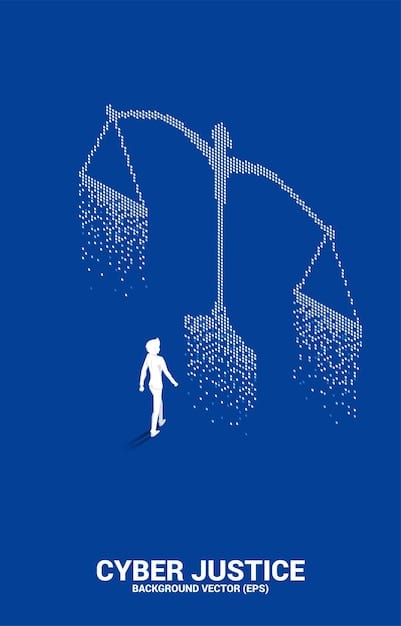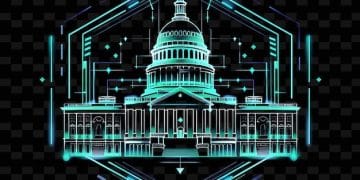Decoding the Future: US Crypto Regulation’s Impact on DeFi

What Does the Future Hold? Analyzing the Potential Impact of US Crypto Regulation on DeFi reveals a complex landscape where potential regulations could either stifle innovation or provide much-needed stability to the decentralized finance ecosystem in the United States.
The decentralized finance (DeFi) sector has exploded in popularity, offering innovative financial services outside the traditional banking system. However, this rapid growth has also attracted the attention of regulators. What Does the Future Hold? Analyzing the Potential Impact of US Crypto Regulation on DeFi is crucial for understanding the evolving landscape and its potential consequences.
Understanding the Current US Regulatory Landscape for Crypto
Navigating the current regulatory landscape for cryptocurrencies in the US is like walking through a maze. Several agencies have a stake in overseeing the crypto market, leading to a fragmented and sometimes confusing environment for businesses and investors alike. Let’s break down the key players and their current approaches.
The Role of the SEC
The Securities and Exchange Commission (SEC) has primarily focused on whether cryptocurrencies and related products should be classified as securities. If a crypto asset is deemed a security, it falls under the SEC’s stringent regulatory framework, requiring registration and compliance with securities laws.
The CFTC’s Involvement
The Commodity Futures Trading Commission (CFTC), on the other hand, regulates commodity derivatives, including Bitcoin futures. The CFTC’s jurisdiction extends to instances of fraud and manipulation in spot markets when they involve digital assets used in derivatives trading. The debate continues about whether specific crypto assets should be classified as commodities.
- The SEC focuses on classifying crypto assets as securities.
- The CFTC regulates commodity derivatives, including Bitcoin futures.
- Differing views exist on whether specific crypto assets are securities or commodities.

The current regulatory framework is often criticized for its ambiguity, particularly regarding the classification of different digital assets. This uncertainty poses challenges for DeFi projects, which operate across borders and often involve complex financial instruments. The lack of clear guidelines can stifle innovation and create compliance risks for businesses operating in the crypto space. A more unified and transparent approach is needed to provide clarity and foster responsible growth in the industry.
Potential Regulatory Approaches and Their Implications
As the DeFi sector continues to evolve, policymakers are considering various regulatory approaches to address the risks associated with these innovative technologies. These potential regulations could impact the DeFi ecosystem in significant ways, shaping its future trajectory. It is essential to consider the varying impacts of these regulatory approaches.
Securities Law Application
One approach involves applying existing securities laws to DeFi protocols and tokens. This would mean that many DeFi projects would need to register with the SEC, comply with disclosure requirements, and potentially restrict access to certain investors. This approach could bring DeFi projects more in line with traditional financial regulations, but it could also stifle innovation and reduce accessibility.
Creating a New Regulatory Framework
Alternatively, regulators could create a new framework specifically tailored to DeFi. This could involve establishing new categories for digital assets, setting specific rules for DeFi protocols, and implementing risk management requirements. A tailored framework could offer more flexibility and better address the unique characteristics of DeFi, but it would also require significant resources and expertise to develop and implement.
- Applying existing securities laws could stifle innovation in DeFi.
- A new, tailored regulatory framework could be more flexible but requires expertise.
- Regulatory sandboxes can allow experimentation with innovative technologies.
Some regulators have also proposed using regulatory sandboxes, which are controlled environments where companies can test innovative products or services without being subject to the full weight of existing regulations. These sandboxes can provide a safe space for experimentation and allow regulators to learn more about the potential benefits and risks of DeFi before implementing broader regulations. The approach taken by regulators will have long-lasting effects on the DeFi ecosystem.

The Impact of Regulation on DeFi Innovation
The impact of regulation on DeFi innovation is a double-edged sword. While some argue that regulation is necessary to protect investors and ensure market stability, others fear that it could stifle innovation and drive activity to less regulated jurisdictions. Finding the right balance is critical to foster a healthy and sustainable DeFi ecosystem.
Fostering Responsible Innovation
Well-designed regulations can help foster responsible innovation by setting clear standards and expectations for DeFi projects. This can attract institutional investors, increase user confidence, and create a level playing field for all participants. By addressing concerns about fraud, manipulation, and money laundering, regulations can help build trust in the DeFi ecosystem.
Potential for Stifling Growth
On the other hand, overly restrictive regulations could stifle innovation and drive DeFi activity to less regulated jurisdictions. This could lead to a loss of economic opportunities and make it more difficult for regulators to monitor and address risks. It is essential to strike a balance between protecting investors and fostering innovation to ensure that the benefits of DeFi are realized.
The optimal outcome must support innovation while ensuring proper guardrails are in place. Finding this balance requires careful consideration is very important.
Challenges in Regulating Decentralized Systems
Regulating decentralized systems like DeFi presents unique challenges compared to traditional financial institutions. The lack of central intermediaries, cross-border nature, and use of smart contracts make it difficult to apply existing regulatory frameworks. Policymakers must develop innovative approaches to address these challenges effectively.
Identifying Responsible Parties
One of the key challenges is identifying the responsible parties in a DeFi protocol. Unlike traditional financial institutions, DeFi protocols often operate without a central management team or legal entity. This makes it difficult to determine who is accountable for compliance with regulations.
Enforcement Difficulties
The cross-border nature of DeFi also poses enforcement difficulties. DeFi protocols can operate across multiple jurisdictions, making it challenging for regulators to enforce regulations and pursue legal action against non-compliant entities. International cooperation and coordination are essential to address these challenges effectively.
- Identifying responsible parties is difficult in decentralized systems.
- The cross-border nature of DeFi poses enforcement challenges.
- Smart contracts add complexity to regulatory compliance.
Smart contracts, which are self-executing agreements written in code, further complicate regulatory compliance. It is essential to ensure that smart contracts comply with applicable laws and regulations, including consumer protection and data privacy requirements. This requires a deep understanding of both the legal and technical aspects of smart contracts.
The Role of Technology in Regulatory Compliance
Technology can play a crucial role in facilitating regulatory compliance for DeFi projects. By leveraging tools like blockchain analytics, identity verification, and automated compliance systems, DeFi projects can streamline regulatory processes, reduce compliance costs, and enhance transparency.
Blockchain Analytics
Blockchain analytics tools can help track transactions, identify suspicious activity, and monitor compliance with anti-money laundering (AML) regulations. These tools can provide regulators and DeFi projects with valuable insights into the flow of funds and help detect potential illicit activities. These tools enable greater transparency.
Identity Verification
Identity verification solutions can help DeFi projects comply with know-your-customer (KYC) requirements. By verifying the identities of users, DeFi projects can reduce the risk of fraud, money laundering, and other illicit activities. Identity verification processes should be privacy-preserving and compliant with data protection laws.
Automated compliance systems can help DeFi projects automate regulatory processes, such as reporting, monitoring, and risk assessment. This can reduce the burden of compliance and free up resources for innovation. Technology offers a path to responsible innovation.
Potential Future Scenarios for DeFi Under US Regulation
The future of DeFi under US regulation is uncertain, but several potential scenarios could play out depending on the approach taken by policymakers. These scenarios range from a highly regulated environment that stifles innovation to a more balanced approach that fosters responsible growth.
Scenario 1: Stifled Innovation
In one scenario, overly restrictive regulations could stifle innovation and drive DeFi activity to less regulated jurisdictions. This could lead to a loss of economic opportunities and make it more difficult for regulators to monitor and address risks. It is essential to avoid regulations that are too burdensome or prescriptive.
Scenario 2: Mainstream Adoption
In another scenario, a well-designed regulatory framework could foster responsible innovation and pave the way for mainstream adoption of DeFi. This could attract institutional investors, increase user confidence, and create a level playing field for all participants. Regulations should be clear, transparent, and proportionate to the risks involved.
- Regulations could stifle innovation and drive DeFi activity elsewhere.
- A balanced approach could foster responsible innovation and mainstream adoption.
- Regulatory clarity can increase institutional investment in DeFi.
Regulatory clarity is essential to attract institutional investment in DeFi. Institutional investors require clear rules and regulations to ensure that they are operating within a compliant and secure environment. A clear regulatory framework can provide the certainty and confidence that institutional investors need to enter the DeFi market. The right regulations are vital for success and sustainability.
| Key Aspect | Brief Description |
|---|---|
| ⚖️ SEC & CFTC | Agencies dispute regulatory oversight. |
| 💡 Innovation vs. Rules | Regulations must balance innovation and compliance. |
| 🌐 Cross-Border Issues | Global nature of DeFi is hard to regulate. |
| 🛡️ Tech Compliance | Tools can aid in regulatory adherence. |
Frequently Asked Questions
▼
Key challenges include the decentralized nature of DeFi, identifying responsible parties, cross-border issues, and ensuring smart contract compliance. Traditional regulatory frameworks struggle with these aspects.
▼
Blockchain analytics tools help track transactions and identify suspicious activities. Identity verification solutions assist with KYC requirements. Automated compliance systems streamline regulatory processes.
▼
The SEC focuses on classifying crypto assets as securities. If deemed so, these assets fall under SEC regulations, requiring registration and compliance with securities laws.
▼
The CFTC regulates commodity derivatives, including Bitcoin futures. Their jurisdiction extends to fraud and manipulation in spot markets involving digital assets used in derivatives trading.
▼
Regulation can either foster responsible innovation by providing clarity and attracting institutional investors or stifle growth by imposing overly restrictive rules and driving activity elsewhere.
Conclusion
Analyzing the potential impact of US crypto regulation on DeFi reveals a complex interplay between innovation and oversight. The future trajectory of DeFi hinges on finding a balanced regulatory framework that fosters responsible growth while mitigating risks. As the landscape continues to evolve, ongoing dialogue and adaptation will be crucial to ensure that the benefits of DeFi are realized in a sustainable and compliant manner.





